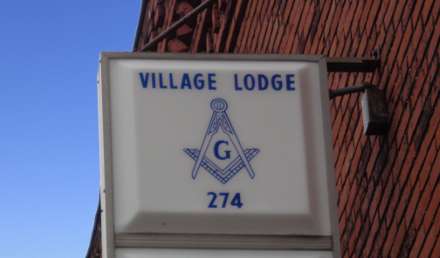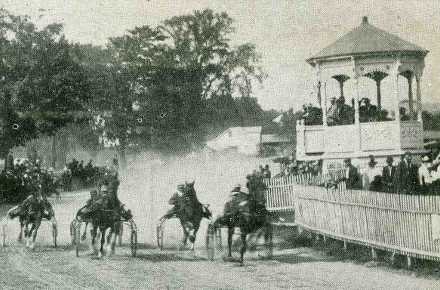
Burton Township’s Founding
Our story begins with the Connecticut Land Company’s first movement to Burton from Painesville on Tuesday, fifth day of June, 1798. Their road followed what is now State St. in Painesville, and staking the township and lot lines, the surveyors literally chopped their way through the dense forest, arriving in Burton one Friday, the fifteenth of June.

After finishing the survey, three men spent the entire day in preparing and drawing out the lots of Burton township. The square was a gigantic growth of forest trees, and our village park, a wildwood. The three men were Turhand Kirtland, William Law, and David Heard. Two of these men were Masons and Freemasonry had begun its work on this community.
Benjamin Johnson came to Burton in 1802, a Mason from Ashtabula’s Rising Sun Lodge #22 and soldier of the Revolution. He built a house across from the fairgrounds and was the first Justice of the Peace, holding the office for two terms. During his tenure of office, when a man was arrested for intoxication, Brother Johnson sentenced him to dig up a stump from the village square and remove it. Brother Johnson was the officiating Justice at the second and third weddings held in Burton, Brother Turhand Kirtland having officiated at the first wedding 1802. When his death occurred Sept. 15, 1825 the funeral service was conducted with both Military and Masonic honors. This was, no doubt, the first Masonic burial service in Burton. Brother Benjamin Johnson’s name once appeared upon a now-lost memorial tablet placed in our park, which he freed from stumps by his judicious imposition of fines on drunkards. Rev. Joseph Badger, another local Mason, was the other name who appeared in that memorial.
Western Reserve’s First Masonic Lodges
In the fall of 1803 twenty-two Masons met in Warren and signed a petition to the Grand Lodge of Connecticut, praying for authority to form a Lodge under its jurisdiction. The petition was carried on horseback to New Haven, where it was presented to the Connecticut Grand Lodge.

On October 19 without any probation, a charter was granted and it was ordered that Turhand Kirtland be the first Worshipful Master, the other officers to be confirmed in their appointments agreeable to the petitioners.
Thus the leader of the first group of men to arrive in Burton was the duly appointed Worshipful Master of the first Lodge of Free and Accepted Masons in the Western Reserve, known as Erie Lodge #47. This lodge continued under the jurisdiction of the Connecticut Grand Lodge until 1808 when a Grand Lodge was instituted in Ohio.
Burton’s first lodge opened in on Tuesday January 10, 1826, called Village Lodge #78. The first representative of Village Lodge #78 in the Grand Lodge of Ohio was Charles C. Paine of Parkman, a very influential man of his community. This session was held in Columbus Jan. 14, 1828 and Village Lodge #78 never was represented in Grand Lodge again, as the lodge closed its doors due to pressure from an anti-Mason movement that was sweeping the nation.
From 1836, there followed a period of about twenty-five years during which time Masonry was practically extinct in Ohio, although some meetings were held very secretly, enough of them to keep the fraternity alive. So intense did the anti-Masonic feeling become that it rocked political parties, sundered churches and religious organizations, and was carried into the social life of many communities. In some portions of Ohio, Lodge halls were destroyed by mobs, records carried away, members ostracized, their business injured, and their families slandered and abused.
Village Lodge #274
Masonry rebounded in Ohio during the mid-1800s. Village Lodge was re-chartered as #274 in July of 1855, and has served the community continuously since that day. The early meetings of Village Lodge were held at different places, often private houses. About the year 1856 a room was secured in the Beach block which was occupied until the removal to the old Odd Fellows Hall in the third story of the former Baird’s Hotel.

In the winter of 1871 a major fire burned down much of Burton Village’s main district, taking Village Lodge’s building with it. A new lodge was constructed shortly afterwards at 14535 N Cheshire St., where the lodge remains to this day.
In 1946, an affiliated chapter of the Order of the Eastern Star (Clover Chapter #201), with the help of Village Lodge, built a booth at the Geauga County Fairgrounds to sell food to fair patrons to raise funds for the community. Today it is still in operation, now run by volunteer members of Village Lodge.
In recent years the lodge has donated funds in support of local Geauga youth, including after proms of local Geauga high schools, the Burton Village Easter egg hunt, and the village’s 4th of July veterans fireworks. Just as Masons served Burton Village at its founding, these are some of the ways Masons today continue the tradition of supporting Burton and the surrounding communities of Geauga County.
